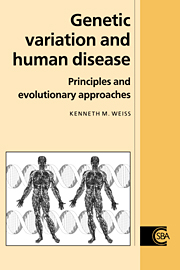Book contents
- Frontmatter
- Contents
- Frontispiece
- Preface: what is this book all about?
- Notational conventions used in this book
- List of abbreviations
- Part I Genes and their expression
- Part II Introduction to genetic epidemiology: inference from observational data
- Part III Evolution: the time dimension in populations
- Part IV Modification of the inherited genotype: the time dimension in individuals
- 12 Phenotype amplification by the environment
- 13 Infectious disease: the response to biological challenge
- 14 Variation within the inherited genotype
- 15 Cancer and aging: a microcosm of evolution during life
- Afterwords: towards a unified general model
- References
- Index
15 - Cancer and aging: a microcosm of evolution during life
from Part IV - Modification of the inherited genotype: the time dimension in individuals
Published online by Cambridge University Press: 05 June 2012
- Frontmatter
- Contents
- Frontispiece
- Preface: what is this book all about?
- Notational conventions used in this book
- List of abbreviations
- Part I Genes and their expression
- Part II Introduction to genetic epidemiology: inference from observational data
- Part III Evolution: the time dimension in populations
- Part IV Modification of the inherited genotype: the time dimension in individuals
- 12 Phenotype amplification by the environment
- 13 Infectious disease: the response to biological challenge
- 14 Variation within the inherited genotype
- 15 Cancer and aging: a microcosm of evolution during life
- Afterwords: towards a unified general model
- References
- Index
Summary
I wish I had the voice of Homer
To sing of rectal carcinoma,
Which kills a lot more chaps, in fact,
Than were bumped off when Troy was sacked.
J. B. S. Haldane, ‘Cancer's a Funny Thing’ (from Clark, 1968)Contrary to the verse by the great population geneticist J. B. S. Haldane, written just after being treated for the cancer that was to take his life, his was among the first generations in which a lot of chaps were bumped off by cancer. Previously most people died from other causes, such as infectious diseases. Although cancers are genetic diseases, selection has prevented most cancers from being directly heritable, but cancer demonstrates the important effects that somatic mutations can have. Cancer reflects evolution in a microcosm, occurring among our own cells during our own lifetime rather than among the individuals in a population over evolutionary time.
Cancer age patterns reflect the time required for somatic mutations to produce their complex cellular phenotypes. This leads naturally to a general consideration of the age patterns of chronic disease and, consequently, of aging in general. These are the subjects of this chapter.
Somatic mutation: the genotype changes with age
An individual begins life as a single cell, but an adult organism is the product of a very large number of subsequent cell divisions that occur as the zygote grows, develops, and renews its tissues. Somatic mutations occur in these somatic cells, and are inherited by their mitotic descendents during the life of the individual.
- Type
- Chapter
- Information
- Genetic Variation and Human DiseasePrinciples and Evolutionary Approaches, pp. 286 - 303Publisher: Cambridge University PressPrint publication year: 1993



